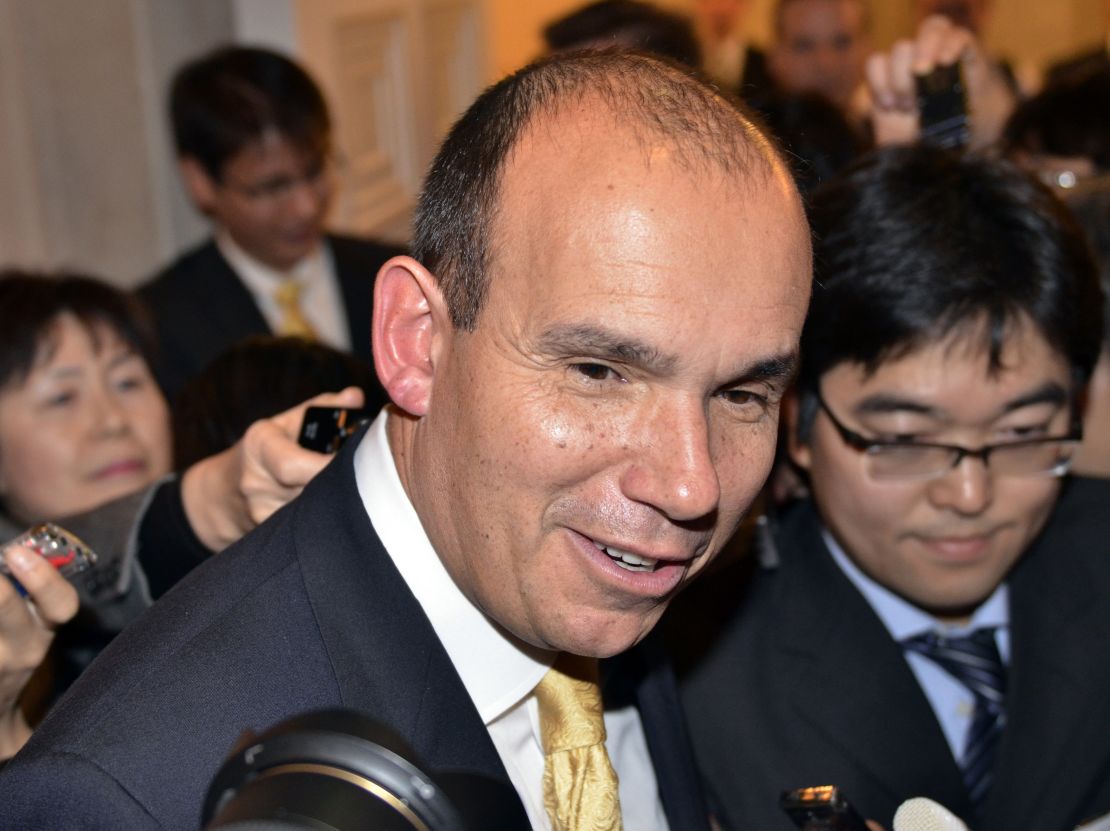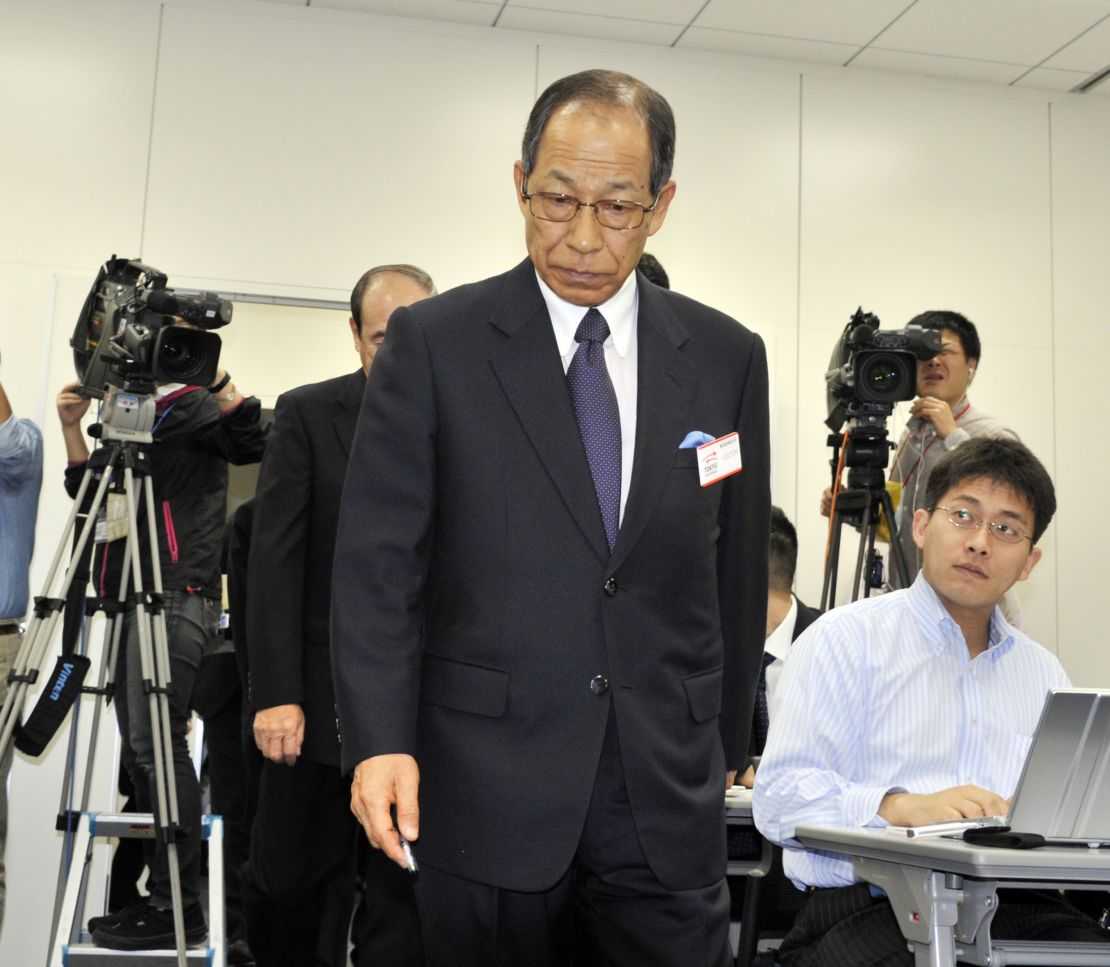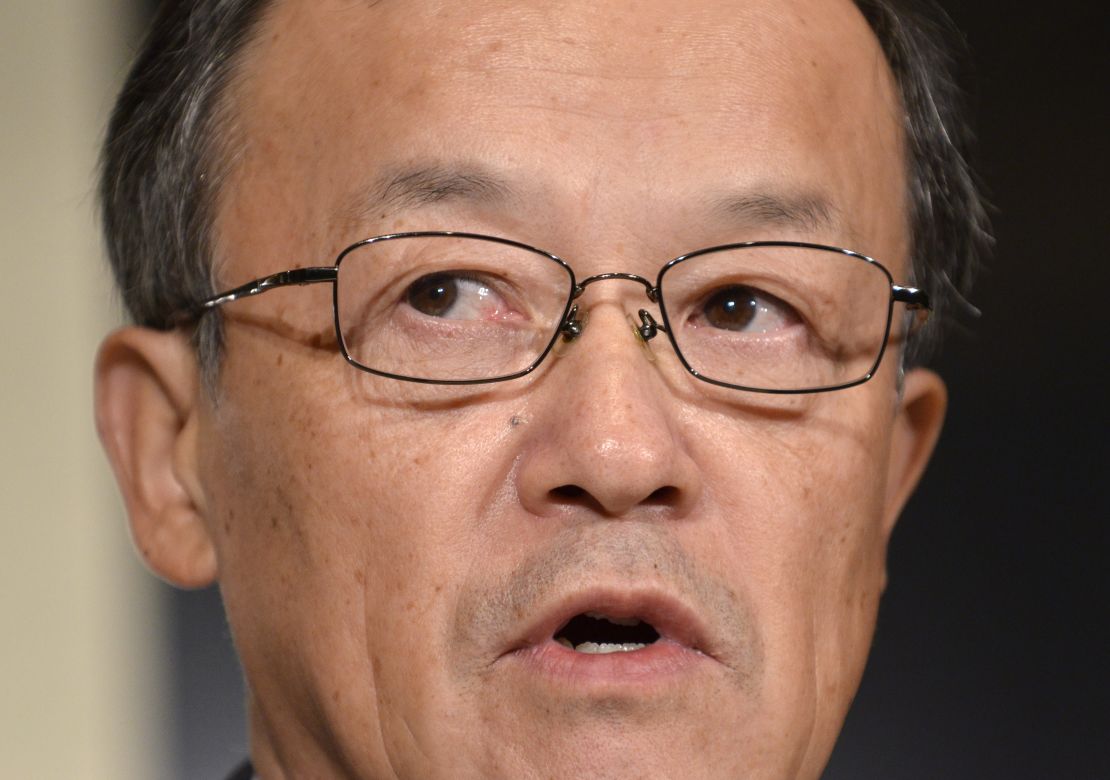Editor’s Note: Former Olympus CEO Michael Woodford’s comments for this story were taken from interviews with CNN and a talk he gave November 25 at Tokyo’s Foreign Correspondent’s Club. Olympus company officials declined to comment on Woodford’s version of events.
Story highlights
Olympus ex-CEO Michael Woodford has likened the cover-up saga as something out of 'a John Grisham novel'
Woodford was fired last month as head of the Japanese company after raising questions over $1.4 billion in payments
The allegations were first raised in an expose in a little-known Japanese magazine in July
A follow-up article in September set in motion a conflict that at one point saw the company lose 75% of its market value
When the ex-CEO of Olympus talked about the saga that had befallen the Japanese company, the story he spun was less Harvard Business Review and more Pulp Fiction.
“I thought I was coming to run a health care company … and a consumer electronics company, and I find myself in this John Grisham novel,” Michael Woodford said last week at the Tokyo Foreign Correspondent’s Club. “Flying to New York to meet the FBI, references to organized crime, boardroom conflicts, character assassination – the whole thing has been a bizarre way to live.”
Perhaps Stieg Larsson is the closer comparison. The Olympus boardroom drama centers around $1.4 billion in losses that company officials now admit were hidden from shareholders and regulators through shady accounting. But much like Larsson’s “The Girl with the Dragon Tattoo” – the first of his blockbuster trilogy that centers around the work of the fictional investigative journal, Millennium, peering into financial misdoings – the Olympus conflict wouldn’t have surfaced were it not for the work of a little known magazine in Tokyo.
“The deeper and deeper we pursued this matter, we could find (there was) a big fraud happening,” said Shigeo Abe, publisher of FACTA, a Japanese publication whose investigative article in July questioning exorbitant fees Olympus – a maker of cameras and medical equipment – paid consultants and extravagant purchase prices of three small companies.
That article, and a subsequent follow-up in September that alluded to possible Japanese mafia involvement, sparked a drama that would find Woodford and three other top Olympus executives out of a job, their company losing billions of dollars in share value. And Olympus – a venerable company emblematic of Japan Inc.’s phoenix-like rise from the ashes of World War II – now faces the possibility of de-listing from the Tokyo Stock Exchange. The alleged accounting tricks mirror the shenanigans of “zombie corporations” that littered the Japanese financial landscape in the post-bubble 1990s.
Board members in Olympus cover-up resign
A five-page expose in FACTA – a small circulation magazine that has only nine-staff – on July 20 raised questions over advisory fees of $687 million paid in 2008 for the purchase of Gyrus, a UK medical instruments firm. The article also questioned the $773 million paid for three small Japanese companies – a face cream maker, a plastic container maker and a recycling business, each with fewer than 50 employees.
The article made no splash when it hit. Although the Japanese media ignored the Olympus scoop, a copy found its way into the hands of one important reader: Woodford.
The FACTA article and its allegations of a $1.4 billion cover-up – a figure more than three times the company’s 2010 profits, according to Woodford – created a behind-the-scenes clash that erupted in a very public way with Woodford’s recent dismissal. The boardroom squabble centered on Woodford – the company’s first foreign president and CEO for just two weeks – and former Chairman Tsuyoshi Kikukawa and his right hand man, former executive vice president Hisashi Mori.
The article also questioned why Olympus chose a “bottom-ranking foreign executive” from 25 candidates. Abe, editor of FACTA, is blunt about why he thinks the choice was made: “Mr. Kikukawa’s aim was to keep the fraud in secret under the foreign president because Mr. Woodford could not speak and read Japanese.”
“Perhaps if a Japanese guy took over, he would have turned a (blind) eye to it – that’s history, let’s move on,” said Peter Tasker, an analyst at Arcus Research in Tokyo. “There’d be no hole in the balance sheet, there wouldn’t be involvement of the FBI and (the UK) Serious Fraud Office, everything would be hunky-dory.
“Woodford basically kicked this hornet’s nest.”
“Where the film script starts”
On Friday, October 14, 51-year-old Woodford rushed home, hastily packed a bag, and went to sit in Tokyo’s Yoyogi Park near an ice cream stand “where I could see all around. There’s mothers with prams and little kids, and I felt quite safe there,” Woodford said.
Then he picked up his phone and dialed Jonathan Soble of the Financial Times. “This is where the film script starts,” Woodford said last week at the FCC in Tokyo, recalling the moment he went from the rare foreign executive of a Japanese firm to high-profile whistleblower.
Earlier in the morning, a hastily called meeting of the Olympus board on issues related to “corporate governance,” was canceled when then-Chairman Kikukawa entered the room. His new agenda: Dismissal of company President Woodford, which the board unanimously approved.
Back at this office, Woodford was asked to turn over the keys to the company apartment, his phones and computers, and told he couldn’t use the company car to get to the airport – he would have to use the shuttle bus.
Echoing in his mind, Woodford said later, was the latest article on Olympus from FACTA, which suggested possible involvement of “antisocial forces” – a Japanese euphemism for yakuza, or mob. “They were acting so bizarrely,” Woodford said. “Anyone who knows Japan knows they avoid confrontation at all costs.”
So with clammy hands, he recalled, Woodford called Soble of the Financial Times. “I wasn’t very good company – I was gibbery and anxious,” he said, on meeting Soble at a coffee shop, where he gave the journalist a black dossier detailing questions about the whereabouts of hundreds of millions of dollars.
Covering up the cover-up
The day seemed an ignoble end of a 30-year career at Olympus for Woodford, a “gaijin salariman” who rose from low-ranking salesman in the company’s medical instruments division to president of Olympus European operations. His elevation to company president in April, handpicked by Kikukawa as his successor, startled many observers – only a handful of foreigners have been tapped to lead a listed Japanese multinational.
Although the Olympus brand is best known to consumers through its camera line, its medical instruments division – such as endoscopes – is its most profitable business with a 70% global market share. Here Woodford’s experience in the medical division helped his rise.
“(Kikukawa) said, `Michael, I can’t change the company, I believe you can’,” Woodford recalled. “I’ve seen what you’ve done in Europe, it’s now the most profitable part of Olympus – will you do it?’ I said, yes, straight away.”
Shortly after Woodford’s April 1 promotion to president, FACTA started putting together the story that would plant the seeds of the conflict that would lead to Woodford and Kikukawa’s ouster from Olympus.



A Japanese friend translated the July 20 article for Woodford. “He told me it looked well-sourced. I found the revelations startling,” Woodford said. “Mr. Abe ruined my illusion of turning Olympus around.”
At a lunch meeting hastily called on August 2, Woodford asked Kikukawa why he wasn’t told about the article. “He said, `You are president, you are too busy’.” Asked if the allegations in the article were true, Woodford claims Kikukawa said: “Most of it – but we’ve made some provisions.”
Woodford began peppering executive vice president Mori about the dubious transactions. Frustrated by the responses, Woodford says he pointedly asked: “Mr. Mori, who do you work for?”
“He said, ‘Michael, I work for Mr. Kikukawa, I’m loyal to Mr. Kikukawa. ‘And I knew at that point there was something horribly wrong at the top of Olympus, something very, very wrong.”
E-mail war erupts
Tensions simmered until September 22, when FACTA published a more detailed follow-up article, this time mentioning the possible involvement in the transactions of J Bridge Corp. – whose chairman in 2009 was convicted of an insider trading scheme – and possible “antisocial forces,” a euphemism for organized crime. “That was enough for me,” he said.
The next day, Woodford wrote an eight-page letter of concerns reflected in the FACTA stories, and sent it to Mori, copying the entire Olympus board. Mori responded that an independent review in 2009 covered his concerns.
“That’s totally unacceptable,” Woodford replied. The e-mail war grew when Chairman Kikukawa chimed in: “I’m very disappointed in this unfruitful e-mail exchange you and Mr. Mori are having,” Kikukawa wrote, according to Woodford.
“So then I switched my letters to him,” Woodford said, sending a fourth letter – this time copying not only the Olympus board, but also the senior partners for Ernst & Young, the company’s outside auditor, in Japan, Europe, the Americas, Asia, as well as Ernst & Young CEO Jim Turley.
In a fifth letter, Woodford threatened not to attend the next board meeting – scheduled for the following Saturday, October 1 – and to resign unless he got responses to his queries. The response to that letter – the company board would officially give Woodford the title chief executive, which Kikukawa had held on to, as well as president.
“That in itself is a bit odd because most presidents in Japan are CEOs but when I was initially offered the job, in later months Kikukawa told me he would be chief executive because Japanese shareholders would like that,” Woodford said.
But at the meetings, directors questioned why Woodford was questioning transactions before his tenure, and questioned why he copied Ernst & Young on the accounting issue.
“I started to feel like a puppet,” he said. “I knew then that although they had agreed to make me president and CEO, they were slapping me, they wanted me to know my place … you may be the CEO, but we run the company.”
The following Monday, Woodford asked accounting firm PricewaterhouseCoopers to commission an independent report on the $687 million in consulting fees.
Neither Ernst & Young nor PricewaterhouseCoopers responded to requests for comment from CNN.
A week later, report in hand, Woodford sent his final e-mail to the group, attaching the report that raised concerns about the transaction, and asked for Kikukawa and Mori to resign.
Instead, at the meeting Friday, the board fired Woodford.
Revenge of the whistleblower
In the ensuing media storm – whose winds were fed by Woodford’s public outcries and repeated interviews with global news organizations, including CNN – the company lost more than 75% of its stock market value. Kikukawa, Mori and auditor Hideo Yamada resigned. New Olympus President and CEO, Shuichi Takayama, said that while the three did not take part in the original losses, they were active in the cover-up of losses dating back to the 1990s.
Olympus started a third party investigation that admitted losses had been hidden through false transactions, but declined further comment on details of the transactions until the independent report is released. The committee has said there was no involvement of Japanese mafia in the scheme.
Meanwhile, Olympus faces a December 14 deadline to refile financial statements to the Tokyo Stock Exchange, or the 92-year-old company will no longer be able to trade.
A key question that is still unanswered: What were the investments that lost such vast sums of cash?
On Thursday, Woodford formally retired from the Olympus board – despite his firing, he remained a board director – in a tactical move to seek the removal of the entire Olympus board. “Let me make it explicitly clear: I am not walking away from Olympus,” he said in a statement. “I would like nothing more than to return to Olympus.”
An Olympus spokesperson said that current board members “will be ready to stand aside once Olympus is on track for recovery.”
Woodford has repeatedly said he would return to the company as president, if asked. So far, he has not been asked.














